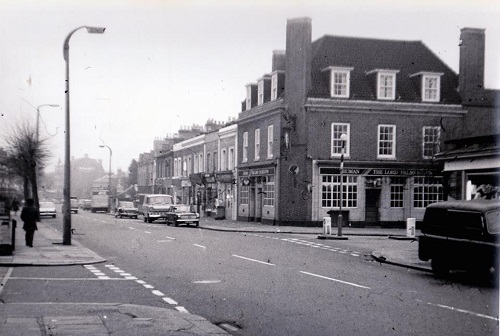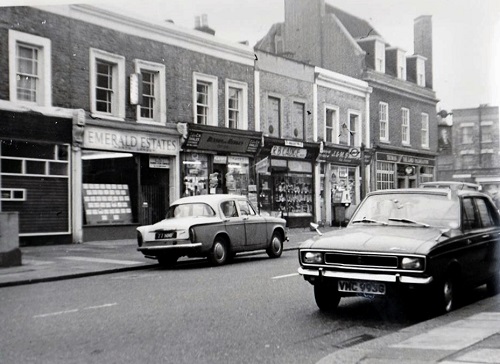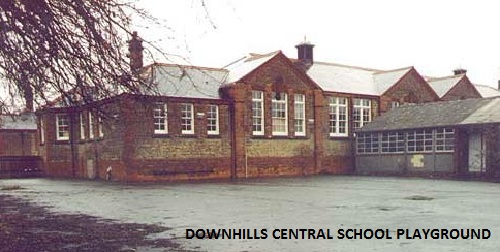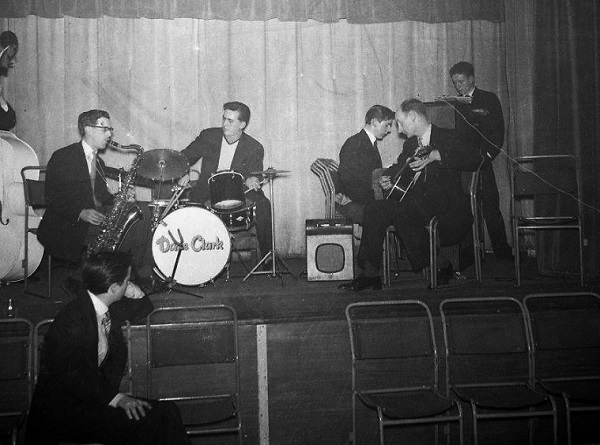|
A FEW
RECOLLECTIONS OF CHILDHOOD CLYDE ROAD 1941 -1965 - DON
VALE |
|
A FEW
RECOLLECTIONS OF CHILDHOOD CLYDE ROAD 1941 -1965 - DON
VALE |
| The
excellent web site created by Alan Swain and his associates has surely given many much
pleasure including myself born at 206 Clyde Road in a rented terrace house owned by a Mr.
Warmisham who lived far away in Martock, Somerset. The memories evoked by the Summerhill pages led me to pen a few of my recollections from living for 24 years on Clyde Road in the Summerhill Road area - before leaving to live permanently in Ontario, Canada. 'The English are a nation of shopkeepers' - Adam Smith or Napoleon? Sandwiched between the old terraced houses along the entire stretch of Clyde Road were so many shops - small grocers(Saunders),small fruit and vegetable shops (Clements), newsagents (Bridcutts), hardware(Burdens) pubs(Lord Clyde), off licenses(Old Brown Jug), sweet shops, bakeries (Clyde Bakery) even a small factory(between # 181 and #183). It all seemed to have just randomly evolved. Now it has mostly disappeared into oblivion. After the War several former shop fronts were converted to front rooms with curtains covering the once public open windows. Examples such as Russell are at 202 Clyde and Hasler’s at 198. |
|
|
With nearby Philip
Lane completely lined with retail shops of every description it seems remarkable so many
shopkeepers selected Clyde Road as their chosen place of business. Growing up I never realised the intensity of the retail competition in the area. At the top Philip Lane end of Summerhill Road which merged into Clyde Road, on a very short stretch we found the Lord Palmerston Pub, Kirby’s Hardware, a Builders Supply Shop, Robbins Dairy, another one time rent-a-book often vacant shop, a Fish/Chip Shop and a Fruit and Veg shop. |
| We
might also mention the rare combination of smells from the Slaughterhouse at the top end
of Summerhill Road mixed with the brilliantine smell from next door Ben’s Barbers
Shop askew at the corner of Summerhill and Philip Lane. Ben’s small shop was adjacent
to a fish shop on Philip Lane.
THIS WONDERFUL OLD PHOTOGRAPH SHOWS ‘HARBY & SON’ AT 220 CLYDE ROAD |
|
 PHILIP LANE –LORD PALMERSTON –CORNER SUMMERHILL ROAD |
PHILIP LANE PARADE OF SHOPS |
 PHILIP LANE PARADE OF SHOPS-TOWARDS PALMERSTON |
PHILIP LANE PARADE OF SHOPS-TOWARDS PALMERSTON TO THE RIGHT-SITE OF PHOTO OLD SLAUGHTERHOUSE AND BENS BARBERS ON THE CORNER |
| Photographs by John Brillus and Michael Diprose | |
| Our
Neighbours: We lived almost opposite the Lord Clyde a small public house with two entrances so typical of most pubs of the times; one entrance was to the public bar the other to a more private sedate saloon area. The Lord Clyde was sandwiched between residential terrace houses. House right of the Lord Clyde was 191 Clyde an elegant well maintained,, comparatively uncharacteristic upscale two storey detached house with a gate, neatly trimmed hedges on either side with a short path to its green majestic front door. Mr. Thomson who was retired, owned 191 Clyde; he often stood at his garden gate in the early evening watching the workers rushing home from nearby Savory Moore aka Lentheric (Perfumes and Fragrances) and Duncan Tucker (Timber and Joiners Works) on Lawrence Road. Mr. Thompson’s wife was French from Amiens. She often helped me with
my French homework. Walking through the door I vividly recall the delightful smell of her
freshly ground coffee beans. |
|
| The
house left of the Lord Clyde was an aging 2 storey terrace house. Here in the basement
from which the street was still visible, lived Mr. Price and his wife. Two other couples
shared the other floors of the house. Mr. and Mrs. Price were flower sellers who sold
flowers from a wheel barrow which they usually parked outside the Lord Palmerston pub at
the corner of Summerhill and Philip Lane. The Prices’ spent much of their time
drinking inside the Lord Palmerston leaving their beautifully stocked flower barrow
outside as a sort of silent salesman. I often purchased flowers for my mother from the Price barrow. As a young choirboy at St. Philips Church on Philip Lane opposite the Lord Palmerston, after the Sunday morning service on the way home I couldn’t resist buying a bunch of anemones from either Mr. or Mrs. Price. They were so generous giving me extra-large bunches. Other neighbours along from Mr. and Mrs. Price were the
Sadler’s, the Walker’s (daughter Ena), the Cornhill’s (son Bobby), the
Warren’s (son Joe) and the Kingsland’s (son Billy). Mr. Kingsland (Sr.) had a
club foot. He lived with his family over his retail shoe repair shop at the corner of
Bedford and Clyde Road. |
|
| At the apex of Clyde
and Summerhill Roads lived the Adams family. Their house was previously occupied by the Oxbridge’s. Mr. Adams was a retired Army Sergeant Major whose parents lived in Clyde Circus. The Adams’ had two children; a daughter Margaret and son Alan.
Pictured Right: Peter Pearman of Summerhill Road alongside Alan Adams in their garden at apex of Clyde Road. In the background you can see Western Terrace Clyde Road |
|
| The
plaster shield high above the door on our outside wall of 206 Clyde stated
‘‘Western Terrace Built 1876”. Each house had outside toilets, no
bathrooms, inside coal cellars, fire grates in most rooms and by this time electricity. No
telephones or creature comforts such as central heating or air conditioning. Western Terrace houses were equipped with coppers in the sculleries for boiling water to wash clothes. The built in coppers had small fireplaces to heat the water. Like many we had a large heavy iron mangle in our garden shed. My mother passed the clothes washed in the copper through two giant wood rollers to squeeze out water before drying them on the clothes line in the garden. Front door steps, unlike those of the Thompson’s opposite, exited straight to the pavement. Our doorstep was polished green. Our front door at number 206 was kept nicely varnished. My mother replaced the upper part of the wooden front with glass on which colourful ‘lead lights’ were positioned to allow light into our otherwise dark narrow passage inside the house. |
|
NEARBY FACTORIES IN LAWRENCE ROAD - DUNCAN TUCKERS AND SAVORY & MOORE (LATER LENTHERIC) |
|
|
|
LAWRENCE ROAD - FORMER PREMISES OF SAVORY & MOORE
|
|
Education and the 11 plus examination: Subsequently, I was fortunate to have opportunities for further education; while working full-time I attended university and pursued undergraduate and post graduate degrees (MBA 1993) largely paid for by my several employers along the way. |
|
|
 |
| The
Central School system was created after the First World War to provide selective secondary
education outside of the existing Grammar Schools. Grammar Schools provided a
"classical education," Central Schools had a vocational bias to suit the needs
of industry, which was beginning to require large numbers of skilled professionals and
managers. They provided a unique opportunity for able students to achieve academic
qualifications, which otherwise would have been denied them. Downhills, like all other
Central Schools, had all the features of a fee-paying school; a special identity of its
own and a house system to encourage friendly competition in all aspects of student
activity, academic and sporting - elements all sadly lacking today.
DOWNHILLS CENTRAL SCHOOL CAP AND BADGE |
|
| The DC5 : When Dave Clark formed his first group, the Dave Clark Quartet, he invited me to join the Group as pianist/arranger. We knew each other only in passing. Dave lived with his family in a flat above the Williams Grocery Shop on Philip Lane corner of Durham Road. Dave Clark attended Belmont School. He worked in real estate with the Wilkinson agency at Bruce Grove. Dave was taking drum lessons with Alan Poulton a professional drummer with whom I regularly practised. While waiting for his weekly lesson Dave heard me playing piano with Alan on drums. That’s how I became Dave’s first pianist arranger while still at Downhills School. We rehearsed in a room above the Greyhound Pub opposite Dave’s home. We had a feeble start playing weddings, parties and dance jive sessions. Dave a Tottenham Hotspur fan agreed to assist raising funds enabling the football team at South Grove Institute to compete in Germany. He organised a highly successful fund raiser for the football club. (https://en.wikipedia.org/wiki/The_Dave_Clark_Five). |
WILLIAMS BROTHERS –PHILIP LANE – HOME OF DAVE CLARK |
| I left Dave’s Group in 1958 to start full time employment with Westminster Bank in Palmers Green. I stay in touch with Dave who now lives in Mayfair and owns several valuable West End properties. His significant musical success was largely due to persistence, determination and his quite confidence as a shrewd businessman - rather than any musical talent playing drums. Dave admits he never really learned to play drums - which incredibly is how he discovered the pulsating London beat which so characterises the DC5. They made 18 appearances on The Ed Sullivan Show – more than any British Invasion group. The group disbanded in late 1970. Dave puts the tremendous DC5 success down to sheer good luck. | |
 THE DAVE CLARK QUINTET - CISSBURY ROAD HALL - OCTOBER 1957 |
 |
| Revisiting
Clyde Road: Since 1974 I have made many return visits to London including revisiting places I knew well in my youth. While memories do not change, places inevitably usually always do. How disappointing then returning to Clyde Road just 9 years after I left for Canada, to find I hardly recognised the area in which I spent my childhood and early adult years. Clyde Road was completely reconfigured hardly recognisable. Some of the street names had escaped the wrecking ball - such as Elizabeth Place, Bedford Road, Lawrence Road and of course Summerhill Road.
PHOTOGRAPH TAKEN FROM THE PEARMAN’S HOUSE IN SUMMERHILL ROAD SHOWING DEMOLITION OF WESTERN TERRACE – CLYDE ROAD My old school Downhills was closed and empty. I had jumped a fence bordering the school field in Downhills Park to get a closer look into the vacant classrooms. Don Vale -July 2018 |
Background Image- original Development plans for Clyde road - Circa 1851